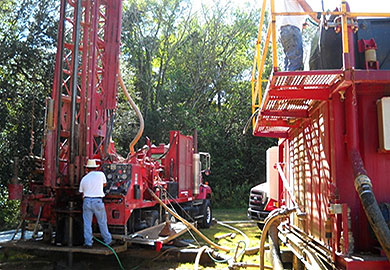DNR News
** Archived Article - please check for current information. **
March 6, 2014
National Groundwater Awareness Week March 9-15
March 9-15 marks National Groundwater Awareness Week and most of us probably give little thought to groundwater on a daily basis, but we should all be aware of just how important it is to both the economy and the environment.
Hydrologists at the S.C. Department of Natural Resources (DNR) are studying and monitoring the groundwater resources of the state. A network of more than 120 wells has been developed over the years to monitor groundwater levels in the major aquifers of the state. Most of these wells are equipped with battery-operated water-level recorders that automatically record hourly water levels and store them on a computer chip. These data are plotted to identify trends in groundwater levels. Data from the network are also used to calibrate computerized groundwater flow models, estimate groundwater flow directions and flow rates, and to assess the impacts of droughts.
See a PDF of SC's Groundwater Monitoring Network>>>
New wells and coreholes are also being drilled to get a better understanding of the depths, dimensions, and properties of the aquifers. Cores are cylindrical samples of the earth that provide information needed to characterize and map the aquifers. In fact, drilling begins on a new corehole this week. The drill site is at  Hobcaw Barony, a 16,000 acre wildlife refuge owned by the Belle W. Baruch Foundation in Georgetown County.
Hobcaw Barony, a 16,000 acre wildlife refuge owned by the Belle W. Baruch Foundation in Georgetown County.
Plans are to collect continuous core samples from land surface to a depth of 800 feet, and to complete a deep monitoring well. The well will be used to measure not only groundwater levels but also groundwater conductivity. Conductivity is a measure of how saline the water is – the higher the conductivity the greater the salinity. This is part of a new monitoring network being developed by DNR hydrologists that will monitor saltwater intrusion of coastal aquifers.
Drilling is scheduled to start March 14 and will likely continue through the rest of the month. Stop by and see what DNR hydrologists are working on. You’ll have an increased awareness and a greater appreciation for this valuable resource we call groundwater. For directions to the drill site, please contact Scott Harder at (803) 734-4764.
Groundwater supplies drinking water to more than 170 towns and cities in the state and to a countless number of citizens that are self-supplied by private wells. Farmers know the value of groundwater – many use it to irrigate their crops. Irrigation use has increased substantially in many counties of the State owing to the increased frequency and duration of droughts that we’ve witnessed during the past 15 years. Industries also use groundwater to produce such things as paper, textiles, and chemicals. Even some thermoelectric plants use groundwater in the production of electricity. Water is heated to generate steam, which in turn drives turbines that produce electricity. Large amounts of water are then needed to cool the steam before it is released into a surface water body or re-circulated.
In terms of the environment, groundwater is a major source of surface water. Sounds odd at first, but we should all be aware that groundwater constantly seeps out of the ground and feeds streams, lakes, and wetlands. This slow but persistent movement of groundwater goes largely unnoticed, but without it many of our surface water sources would go dry during droughts. It is estimated, for example, that 60-70 percent of the water in our streams originates as groundwater.
Groundwater is, by far, most abundant in the Coastal Plain Province, a region of the state that is underlain by layers of loose sand, limestone, and clay. Pores in the sand and limestone fill with rainwater that seeps into the ground. These layers form underground reservoirs called aquifers. Aquifers of the Coastal Plain can be hundreds of feet thick and reach depths of several thousands of feet. Wells tapping such aquifers can be pumped to produce thousands of gallons of water per minute. Unlike water that occurs in surface reservoirs, however, groundwater moves rather slowly, on the order of several hundred feet per year. As a result, we should all be aware that aquifers can be pumped at rates that exceed recharge rates. In these cases, water levels in an aquifer can drop and undesirable consequences can result, such as saltwater intrusion, land subsidence, sinkholes and dry wells.
More News
- Spring turkey hunters should order tags now for upcoming season
- Reel Art contest winners announced
- Adult-youth fishing open at Bonneau Ferry
- DNR hosts series of youth fishing rodeos/family fishing clinics around the state
- Benefits of prescribed burning are many, but managers finding it harder to burn
- National Groundwater Awareness Week March 9-15
- Duck hunters finish the season on DNR Waterfowl Management Areas
- Humane Society-South Carolina recognizes DNR Law Enforcement on bear baiting
- Antler measuring sessions set across South Carolina
- 2nd Annual SCDNR Youth Bass Fishing Championship to be held on Lake Murray March 29
- Lake Edwin Johnson drawdown for new pier
- Freshwater fishing trends
- Saltwater fishing trends
- S.C. weekly tidetable
- DNR video
- Archived news releases
